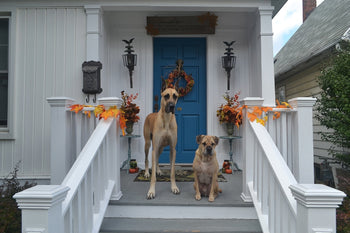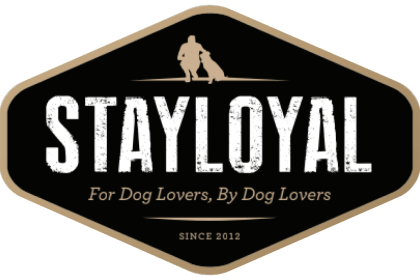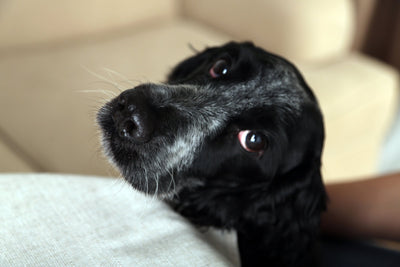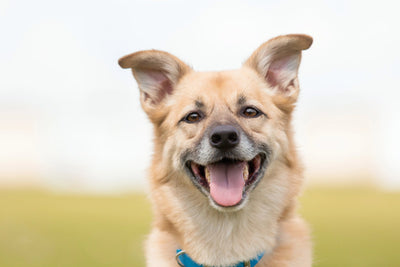Teach Your Dog Door Manners

With everyone home more at the moment, now is a great time to teach your dog door manners. Doors are naturally arousing to dogs – whether they are excited or stressed – the anticipation of going through them or seeing who is coming in can cause even the best-behaved dog to bark, rush the door, and a host of other behaviours. Regardless of why your dog is doing it, these behaviours are annoying but can also be dangerous. Dogs that rush doors can escape. A dog that barks and jumps at whoever comes in could knock down a child or injure an elderly person, or cause you to trip as you come in with your hands full of groceries.
Teaching door manners involves both management and training. Management will be the first thing you do. Until your dog has learned what they are supposed to do at the door, you will want to manage him so he cannot practice the unwanted behaviours.
Managing means setting up your house and your dog in such away that your dog cannot practice the unwanted behaviours – such as rushing the door. Please note, there is no verbal way to stop your dog from rushing the door if someone rings the bell or knocks before they have been trained. Therefore, when we talk about management, we mean making sure your dog can’t rush the door and escape or injure someone by restraining them in some way.
There are several things you can do to manage the door while your dog is in training.
Barriers. Use baby gates or an exercise pen to block off the doorway area so your dog cannot rush it whenever someone comes to the door. This works for dogs that respect barriers only. If your dog can jump over them or if the barriers cause aggression, do not use this management tool.
Confinement. If you know someone is coming, or you know you are going to be coming back with your arms full, crate your dog or close them off in another room so that he cannot approach the door when you or your guests enter. For guests, bring them in, have them sit down and get settled, and then bring your dog out on a leash. This helps your dog not clobber them as he is greeting them and since he is leashed, you can remove him if he gets too excited.
If it’s the sound of the door bell or knock that interests your dog, put a note on your door telling people to text you instead while you are in the training phase.
The more times your dog gets to practice the unwanted behaviour, the longer it will take, so management is important!
Training Door Manners
Now it’s time to train your dog to be respectful at the door. There are several ways you can do this, it’s really up to you, what your dog’s unwanted behaviour is, and your house set-up. And, this is not a complete list. You can decide on any wanted behaviour chain that works for your house and use the same concepts outlined here to train it.
Sit/lie down at door. If your excited pooch just wants to greet everyone that comes through the door OR she wants to rush out, a simple solution is to train an auto stay in either a sit or a lie down. This means that the opening of the door becomes a cue to your dog to stay in place until you release them. To start training this, have your dog on leash and stand by the door. Wait for your dog to sit or lie down and then reach for the door to open it. If she gets up, stop reaching for the door, return to your original position, and wait for them to sit again. Do this until you can open the door all the way without your dog moving. At this point, close the door and say your release word (or make one up if you don’t have one) while getting your dog up – you can throw a treat or a toy – so they learn they need to stay until released.
Then you will need to build up to being able to walk out the door while your dog stays in the sit. Again, no cue. We want your dog to learn that an open door means “sit/down and stay” without a cue. Not everyone entering the house will know the cue, or if you are talking on the phone you don’t want to get clobbered because you forgot to cue the dog.
Finally, introduce other people into the equation. Don’t be surprised if you have to go back a few steps with someone new until your dog has generalized the behaviour.
Alternate Behaviour. Another option for dogs that rush the door or that bark, is to teach them to do something instead. This gets their mind focused on the “task” instead of barking or rushing. Usually, this would be something like going to their crate or a favourite dog bed and lying down, when they hear a knock or bell ring. Do this by teaching your dog the behaviour with a cue (so you can also cue it for times when there is no knock or bell). Then, teach the secondary cue(s) by ringing the door bell, saying the cue, and then rewarding the behaviour. After a bit of practice, your dog will start moving toward their crate or bed before you say the cue, after the bell. That’s when you know they are starting to put the two together and you can test it by not saying the verbal cue. You can repeat this process with the knock at the door as well, or even by using the door opening as a cue, like the above behaviour.
Get Back. Some dogs do not bolt out the door, jump on you, or bark – they just get underfoot. For these dogs, a “get back” cue might be all you need. This teaches the dog to do a one 180-degree turn and move away from you, out from under your feet. Do this by throwing treats behind your dog so he chases them while saying “get back.”
Remember, these are just suggestions. You can combine or change these behaviours to best fit you and your dog. Managing the door while training some nice behaviours can make the entrance of your home pleasant once again and safer for both human and canine.








